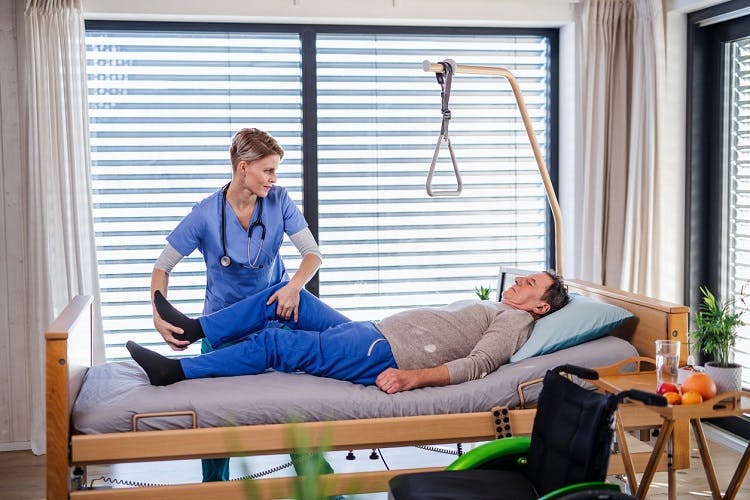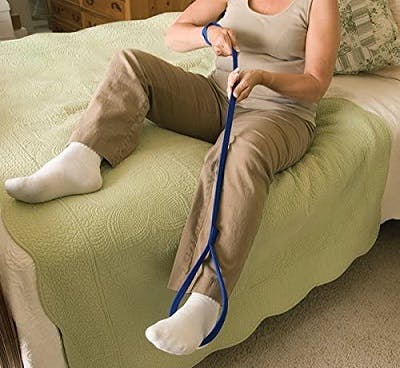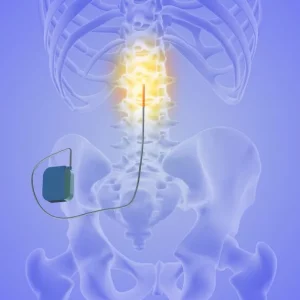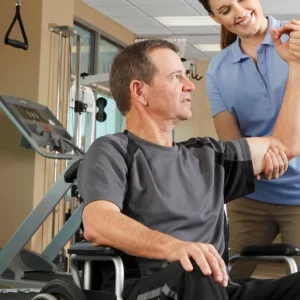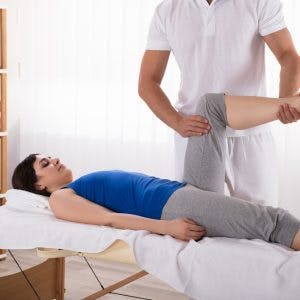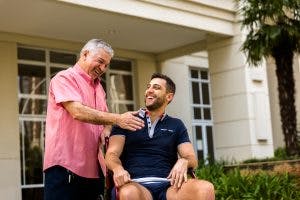Practicing bed mobility exercises after a spinal cord injury (SCI) can help improve your ability to transfer in and out of bed and sit upright.
After a spinal cord injury, individuals may experience various degrees of paralysis in the arms, trunk, and legs. This can significantly impact one’s independence and make everyday tasks more challenging. By developing bed mobility skills, individuals can greatly improve their overall quality of life.
To help you develop your bed mobility after spinal cord injury, this article will share:
Helpful Bed Mobility Exercises for Spinal Cord Injury Patients
Generally, bed mobility requires some use of one’s arms, so we recommended these exercises for individuals with paraplegia (paralysis of the lower body) who can bend and straighten their elbows and wrists after SCI. However, some individuals with quadriplegia (paraplegia of the lower and upper body) may be able to perform these exercises as well.
Make sure to practice these bed mobility exercises on a bed (not the floor) so that you can get accustomed to how the mattress may affect your movement and momentum.
Additionally, make sure that there aren’t any hard objects (like phones or remotes) on the bed and that the sheets are not bunched up. After a spinal cord injury, individuals may be unable to feel if they are on lying on an object. Consequently, prolonged pressure on the skin can cut off blood flow and increase the risk of developing pressure sores.
Without further ado, let’s get into the bed mobility exercises for individuals with spinal cord injury. They may be challenging at first, but the more you practice, the better you’ll get at shifting your weight, lifting your upper body, and sitting upright.
1. Body Twists
This bed mobility exercise for spinal cord injury patients teaches you how to roll to your side.
First, make sure you have enough room next to you to safely roll over. Then, use your arms to move your right leg over your left leg.
While lying on your back, lift your head and thrust your arms to the left. You may need to rock back and forth a few times in order to gain momentum before the roll. Use the momentum of the swing to roll the rest of your body to the left side.
Repeat on the other side. This time, your left leg should go over your right leg as you roll to the right.
2. Reverse Push-Ups
This bed mobility exercise helps strengthen your arms and practice transitioning into an upright position.
Lay on your back with elbows bent outward. Then, push down with the hands and straighten the elbows to prop the upper body up.
Practice lowering the body by bending the arms and lifting the body by straightening the arms.
To get into a fully upright position, straighten the elbows and alternate shuffling the arms towards your hips. To lie down again, shuffle your arms backward while your torso lowers towards the mattress.
3. Mild Hamstring Stretch
Depending on the level and severity of your spinal cord injury, you may experience paralysis in the trunk and legs (paraplegia), which can make it challenging to sit upright. This bed mobility exercise can help you develop sitting balance.
Sit with your legs straightened in front of you and lean slightly forward, towards your toes. Leaning forward helps prevent you from falling back while having your legs straightened adds enough resistance in the hamstrings to prevent falling forward.
4. Lateral Trunk Lift
For some, it can be easier to get up by leaning to one side. This bed mobility exercise for spinal cord injury patients helps you practice lifting the trunk from the side.
Roll over to your right side (see exercise #1), prop your upper body up with your right forearm, and use your left arm to help keep you balanced.
Press down with your right hand as you straighten the right elbow to lift the torso. Your body should almost look like a sideways “J.”
Up next, we’ll discuss adaptive tools that individuals with spinal cord injuries can use to improve their bed mobility.
Adaptive Tools to Improve Bed Mobility
In the beginning of recovery, individuals with a spinal cord injury may need to rely on adaptive tools for extra support as they develop their strength and mobility.
Below, we’ll discuss 3 adaptive tools that can make bed mobility much easier:
- Leg Lifter. Especially if you have paralysis in the lower body, you might struggle to lift and move the legs. In such cases, individuals with paraplegia can use a leg lifter, which is a rope with a loop at each end. Place a foot inside one loop and your arm in the other loop. Then, use your arms to maneuver the leg in and out of bed.
- Bed Rail. A bed rail is a handle that slides under the mattress to provide a safe and stable surface to hold onto as you transfer on and off your bed.
- Bed Rope Ladder. A bed rope ladder is an assistive device that attaches to your bed frame. By working your way up the rungs, you can get into an upright sitting position. Similarly, by working your way down, you can lower yourself into a flat position.
It’s important to understand that, while adaptive tools can be very helpful, individuals should only use them as needed.
The only way to improve your functional abilities after a spinal cord injury is through repetitive and task-specific practice. When individuals rely too heavily on adaptive tools, they‘re not practicing the movements necessary to promote neurological adaptations in the spinal cord.
Ultimately, patients with a spinal cord injury should aim to wean off adaptive tools. In the following section, we’ll discuss how participating in physical and occupational therapy can help some individuals with an SCI improve their bed mobility skills.
Rehabilitative Therapies That Can Help Improve Bed Mobility
Generally, bed mobility is a skill that patients can practice in occupational therapy for spinal cord rehabilitation. However, physical therapy can also play an essential role in improving bed mobility.
Occupational and physical therapy both aim to maximize mobility after spinal cord injury, but in different ways. Typically, occupational therapy takes a transferrable approach to rehabilitation in which individuals practice daily activities like getting dressed and bathing. In contrast, physical therapy involves exercises like stretches and strengthening exercises to restore movement.
In other words, occupational therapy exercises have a more direct application to everyday life while physical therapy exercises focus on developing the strength, flexibility, and balance necessary to perform those activities.
While individuals learn how to use adaptive devices and practice various bed mobility exercises at occupational therapy, they can also benefit from developing the arm, core, and leg muscles at physical therapy.
Improving Bed Mobility After Spinal Cord Injury
Bed mobility exercises can help individuals with paraplegia and quadriplegia after spinal cord injury improve their functional independence.
The outcomes of every spinal cord injury are different, so don’t worry if you can’t perform all of the bed mobility exercises just yet. Experiment, adjust, and find what works best for you. The more you practice, the easier the exercises should get.
